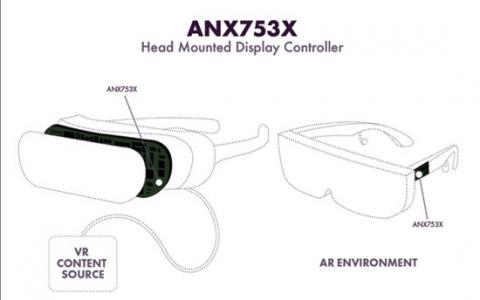How USB Type-C Can Drive AR and VR Development
By Caroline Hayes, Senior Editor
There has been a flurry of activity and excitement around USB Type-C, which promises not only to connect a variety of peripherals to an electronic device, but also to reduce the height needed for the USB port, and create slimmer smartphones, Virtual Reality (VR) and Augmented Reality (AR) devices.
“The universality of USB Type-C to provide the power, data, and display needed to drive any AR or VR headset has several potential benefits.”
Rather than defining speed or features, the USB Type-C (also known as USB-C) protocol targets the physical connection of host and client. A single socket can be used to connect peripherals and power to a device. For some smartphone manufacturers, the biggest advantage is that it can mean the end of the headphone jack, a bulky port whose elimination can slim down smartphones. Apple ditched that port in the iPhone 7.
“Over time, the full-featured USB-C cable will replace High Definition Multimedia Interface (HDMI) cables, indeed all cables, to become the ubiquitous way to transfer power, data, and video,” says Andre Bouwer, Vice President of marketing, Analogix.

Andre Bouwer: USB Type-C offers universality to appeal to consumers.
USB Type-C supports USB 2.0 and USB 3.0 protocols, operating at up to 2.5 and 4.5W respectively, and additionally supports the USB Power Delivery (PD) protocol. The PD protocol, explains Bouwer, has a dual-role capability to provide up to 15W to an attached device at 5V. The same power can also be used to receive up to 100W from a charger, to power peripherals.
For data, USB Type-C is designed to support data throughput of up to 10Gbit/s, matching the USB 3.1 Gen2 standard, which doubled the data throughput of USB 3.1 Gen2, typically found in PCs.
Cables can support up to 8.1Gbit/s display throughput, enabling DisplayPort v1.4 to connect a video source to a display. “Since USB is ubiquitous there are, starting from this year, more full-featured USB Type-C cables than HDMI cables,” says Bouwer. “Furthermore, it is the only widely available cable in consumer electronics that can carry Full Ultra High Definition (FUHD /8K video. All these capabilities are negotiated when devices are connected,” he adds.
Reducing the Nest
The biggest benefit to end users is the universality it offers, says Bouwer. “Every notebook computer owner knows what it feels like to arrive at your hotel without your charging cable,” he says, recalling having to buy or borrow USB charging cables in such circumstances. It also means shrinking that nest of cables in the home and/or office ‘accessory drawer.’ “The universality of USB-C also allows consumers to reuse cables across multiple devices and locations. For example, if you buy a new phone and like to have a second charging cable in your car, then you can keep your old cable instead of buying another one,” points out Bouwer.
The USB Type-C connector is reversible, so can be fitted easily, even if the port is at the back of heavy or bulky equipment, without having to move the whole unit.
Anticipating the take-up of USB Type-C, Analogix introduced the ANX7XX family of USB Type-C controllers. Each controller contains the port controller and the high-speed switch needed to handle the USB-C cable configuration for both data and display. “As such, device makers can enable full function USB-C support by adding just one IC to the design,” says Bouwer.
The largest model in the series is the ANX7428, which has USB Type-C support for power supply up to 100W, data transfer to USB 3.1 Gen1, USB and DisplayPort switch operation for use with external displays, and 8K resolution by four DisplayPort lanes. Other controllers in the series have two DisplayPort lanes, for use with smartphones and ARM-based tablets, while others focus on one element, such as DisplayPort, high-speed switching, or the USB power supply.
AR and VR Headsets
In addition to the established repertoire of end users, PCs, and smartphones, Bouwer anticipates the use of USB Type-C in Augmented Reality (AR) and Virtual Reality (VR) headsets. An obstacle for AR and VR developers today is that the headsets use proprietary protocols and connectors. “For example, a PC optimized for Oculus will not work with Sony, and vice versa. This is an obstacle for gaming software and video content developers,” says Bouwer.
The universality of USB Type-C to provide the power, data and display needed to drive any AR or VR headset has several potential benefits. “In particular, USB-C can simultaneously power the headset, so that it doesn’t need to have a battery inside, transfer high-definition video to both eyes using DisplayPort, and transfer high-bandwidth data needed for sensors in the headset to track and communicate the head position and movements,” Bouwer explains. “DisplayPort over USB-C will enable the next generation of high-performance, lightweight and comfortable headsets,” he predicts.
Standardizing the headset connector using DisplayPort over USB-C will allow a VR computer from one manufacturer to work with a headset from another vendor. “This motivates content and equipment developers to invest in new AR and VR products,” enthuses Bouwer.

Figure 1: The Slimport ANX753X display controllers launched by Analogix in January provide high resolution and fast response times for VR and AR.
The company has recently introduced the Slimport ANX7530, ANX7533 and ANX7580 DisplayPort to Quad MIPI-DSI display controllers for VR and AR. They can be used in USB Type-C and non-USB Type-C applications to manipulate video scan modes (Figure 1). The controllers will sample Q1 and ship in mass production in Q2.
Another connection option is Intel Thunderbolt™devices. “Intel Thunderbolt provides even higher bandwidth for both data and display, 20Gbit/s today and going even higher in the future,” says Bouwer. “All Thunderbolt devices are backwards-compatible with DisplayPort and USB. Therefore, Thunderbolt can be thought of as an extension of these, and over time, become an important new element in the USB Type-C ecosystem.”
 Caroline Hayes has been a journalist covering the electronics sector for more than 20 years. She has worked on several European titles, reporting on a variety of industries, including communications, broadcast and automotive.
Caroline Hayes has been a journalist covering the electronics sector for more than 20 years. She has worked on several European titles, reporting on a variety of industries, including communications, broadcast and automotive.
